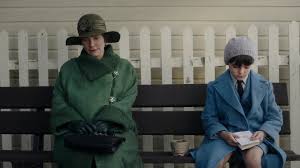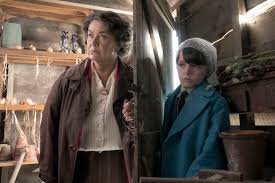Roald & Beatrix: The Tale of the Curious Mouse – A Heartwarming Celebration of Storytelling
Stories shape the way we understand the world. They spark imagination, comfort us in difficult times, and remind us of shared humanity. In 2020, Sky One released Roald & Beatrix: The Tale of the Curious Mouse, a festive film inspired by a true but little-documented encounter between two literary giants: Beatrix Potter, the beloved creator of Peter Rabbit, and Roald Dahl, the celebrated author of Charlie and the Chocolate Factory, Matilda, and countless other classics.

This 90-minute Christmas film is more than just a charming dramatization of a historical moment. It is a meditation on grief, childhood wonder, the endurance of creativity, and the power of stories to connect people across generations. With an enchanting atmosphere, whimsical tone, and heartfelt performances, Roald & Beatrix invites audiences to rediscover the magic of books and the resilience of the human spirit.
In this article, we will take a comprehensive look at the film—its story, inspiration, production journey, performances, critical reception, and its broader cultural significance. We will also explore the timeless themes it addresses, from the pain of loss to the comfort of creativity. By the end, it will be clear why this modestly scaled film has left such a warm mark on viewers’ hearts.
The Storyline: A Meeting Across Generations
The film is set in 1922, in the aftermath of World War I, a time marked by grief and recovery.
Roald Dahl is portrayed as a six-year-old boy dealing with a profound loss: the death of his father and sister. Struggling to process his grief, Roald finds comfort in books, particularly those of Beatrix Potter, whose whimsical tales of rabbits, mice, and countryside creatures bring light to his dark world.
Beatrix Potter, meanwhile, is nearing the end of her career. Played by Dawn French with warmth and poignancy, Potter is portrayed as weary, struggling with failing eyesight, and experiencing creative burnout. She feels distanced from the imaginative spark that once drove her to write and illustrate beloved animal tales.
When young Roald sets out—alone, with a mix of innocence and determination—to meet his literary idol, their worlds collide. The heart of the story is this imagined meeting: a child full of curiosity and sorrow, and a seasoned storyteller grappling with fading inspiration. Their encounter highlights the cyclical nature of creativity: the old inspires the young, and the young remind the old why stories matter.

Inspiration: A Legend Rooted in Truth
Though the exact details are murky, there is historical basis for the film’s premise. Biographers have noted that a young Roald Dahl once visited Beatrix Potter in her Lake District home. Dahl himself mentioned the visit in passing, though accounts vary regarding how much interaction they actually had. Some suggest the meeting was brief and not especially warm—Potter, by then, was a private woman, perhaps not inclined toward unexpected visitors.
But the essence of the encounter—that a boy who would become one of the 20th century’s greatest storytellers once crossed paths with the woman who defined children’s literature for the generation before him—is irresistible. The filmmakers embraced the imaginative possibilities of dramatizing this meeting.
Rather than focusing strictly on historical accuracy, Roald & Beatrix uses artistic license to craft a fable-like narrative. The story becomes less about what “actually” happened and more about what such a meeting symbolizes: the torch of creativity being passed from one writer to another, bridging grief, time, and generations.
Casting and Performances
The film succeeds largely because of its casting, which breathes warmth into the whimsical premise.
Dawn French as Beatrix Potter
Dawn French, a household name in British comedy, brings tenderness and humor to Potter. She plays her as a woman caught between fatigue and imagination—part grumpy recluse, part whimsical dreamer. French’s performance balances poignancy with wit, capturing a creative spirit who, though tired, still possesses an inner spark waiting to be rekindled.Harry Tayler as Roald Dahl
Young Harry Tayler gives a remarkably moving performance as the six-year-old Roald. He embodies curiosity, innocence, and quiet determination, carrying the emotional weight of the story with authenticity.Rob Brydon, Jessica Hynes, Alison Steadman, and Bill Bailey
Supporting cast members add humor and depth. Rob Brydon provides comic relief, Jessica Hynes portrays Roald’s mother with warmth and strength, while Alison Steadman and Bill Bailey bring charm in smaller roles.
Together, the ensemble creates a world both magical and grounded, whimsical yet emotionally resonant.

Themes at the Heart of the Film
While charming and festive, Roald & Beatrix also delves into weightier themes that give it lasting depth.
1. Grief and Healing
Roald’s grief over his father’s and sister’s deaths is the emotional anchor. The film portrays how books can provide solace when the world feels unbearable. In finding courage to seek out Beatrix, Roald begins to heal by embracing imagination.
2. Creativity Across Generations
Beatrix represents an artist near the end of her creative journey, while Roald symbolizes new beginnings. Their meeting shows how stories endure beyond individual lifetimes, passed from one generation to another.
3. Childhood Innocence and Courage
Roald’s journey to find Beatrix highlights the resilience of children. His bravery contrasts with Beatrix’s weariness, reminding viewers that youthful curiosity can reignite even the most tired hearts.
4. The Magic of Storytelling
The film celebrates books as lifelines—sources of comfort, wonder, and connection. Beatrix’s tales gave Roald strength, and in turn, Dahl’s works would inspire millions of children decades later.
Production Design and Atmosphere
The film is visually enchanting, with careful attention to period detail and whimsical touches.
Cinematography: Soft lighting and warm tones create a nostalgic, almost storybook-like atmosphere.
Costume Design: Authentic 1920s clothing immerses viewers in the era.
Set Design: From the cozy interiors of Beatrix’s countryside home to the bustling streets Roald travels, the sets evoke both realism and magic.
Narrative Devices: Occasional animated flourishes bring Beatrix’s illustrations to life, reminding audiences of the imaginative world she created.
The overall effect is a blend of grounded period drama and whimsical fairy-tale charm—perfect for a Christmas broadcast.
Critical Reception
When Roald & Beatrix: The Tale of the Curious Mouse aired on Christmas Eve 2020 on Sky One, it was warmly received.
Critics praised the performances, especially Dawn French’s heartfelt portrayal of Beatrix.
The visual design and whimsical tone were highlighted as strengths.
Some reviewers noted that the story was simple and leaned on sentimentality, but for many, this was part of its charm.
Families appreciated its festive, heartwarming spirit, making it a suitable holiday watch.
For audiences weary from the challenges of 2020—a year dominated by the global pandemic—the film provided comfort, nostalgia, and a gentle reminder of the enduring power of imagination.

Cultural and Educational Significance
Beyond its role as festive entertainment, the film has broader significance:
Introducing New Generations to Beatrix Potter and Roald Dahl
Many young viewers may know Dahl’s works but not Potter’s, or vice versa. The film acts as a gateway, sparking interest in both authors’ legacies.Encouraging Conversations About Grief
By gently depicting Roald’s loss, the film offers parents a way to discuss difficult topics like death and healing with children.Celebrating British Literary Heritage
The imagined meeting symbolizes continuity within the rich tradition of children’s literature in the UK, honoring both Potter’s Victorian-era tales and Dahl’s mid-20th-century classics.Inspiring Creativity
At its core, the film reminds viewers—young and old—that storytelling is a way to make sense of life, preserve memory, and share joy.
Comparing the Legacies of Potter and Dahl
Though different in style, Beatrix Potter and Roald Dahl share striking similarities in how they shaped children’s imaginations.
Beatrix Potter (1866–1943): Best known for The Tale of Peter Rabbit, her works emphasize gentle lessons, anthropomorphic animals, and pastoral settings. Her illustrations remain iconic.
Roald Dahl (1916–1990): Known for darker humor, inventive plots, and child-centered narratives, Dahl’s works include James and the Giant Peach, The BFG, and Matilda.
Both writers emphasized children’s perspectives, challenging adult authority and celebrating imagination. By dramatizing their symbolic “meeting,” the film underscores how literary traditions evolve while maintaining a shared spirit of wonder.
Broader Context: Storytelling in Times of Crisis
Released during the COVID-19 pandemic, the film resonated strongly because of its themes of loss, resilience, and imagination. Just as Roald turned to books to cope with grief, many families during 2020 turned to stories—whether books, films, or television—for comfort and escapism.
The timing of the release gave Roald & Beatrix added poignancy. It reminded viewers that even in dark times, stories help us endure and find joy.
Audience Appeal
The film appeals across generations:
Children are charmed by the whimsical tone, magical illustrations, and Roald’s adventurous spirit.
Adults appreciate the layered themes of grief, inspiration, and artistic legacy.
Families together can enjoy it as both entertainment and a conversation starter about literature, resilience, and creativity.
Its cross-generational appeal mirrors the enduring works of both Potter and Dahl, which continue to be read by children and cherished by adults.
Conclusion: Why Roald & Beatrix Matters
At first glance, Roald & Beatrix: The Tale of the Curious Mouse may seem like a modest holiday special. But its charm lies in how it uses a simple premise—a boy meeting his literary hero—to explore universal themes: grief, inspiration, the cycle of creativity, and the magic of stories.
By reimagining this historical encounter, the film gives us a fable about the endurance of imagination. It reminds us that storytellers shape not only their own time but also generations to come. Beatrix Potter once gave a grieving boy the courage to dream, and that boy grew up to give millions of children stories that changed their lives.
In celebrating this connection, the film becomes more than just festive entertainment. It becomes a tribute to the timeless power of stories, the resilience of the human spirit, and the beautiful way imagination binds us all.
